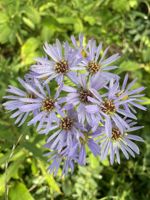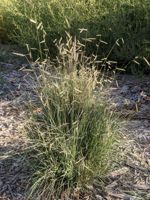Mon-Fri 9am - 5pm Mountain time
Showy Aster vs Blue Grama Grass
Eurybia conspicua
Bouteloua gracilis
CUSTOM GROW
NOT AVAILABLE THIS SEASON - MIGHT RETURN
Showy Aster is a native perennial wildflower recognized for its tall stems topped with clusters of light purple blooms. Blooming from late summer into autumn, it provides an important late-season source of nectar and pollen for pollinators. It also produces seeds that are eaten by birds, extending its value to wildlife beyond the flowering season.
Drought tolerant once established, Showy Aster grows well in urban, rural, and disturbed sites. With its mix of ecological value and ornamental appeal, it is ideal for pollinator gardens, naturalization projects, and ecological restoration.
Blue Grama is a native perennial bunchgrass recognized for its blue-green blades and unique seed heads. They grow along one side of the stem and are often compared to eyelashes, eyebrows, or mosquito larvae, which inspired its common names, Eyelash Grass and Mosquito Grass. As the seed heads begin to dry in the fall, they curl, further enhancing the plant’s distinctive appearance. The seeds provide food for birds, and the grass serves as a host plant for certain species of skipper butterflies.
As a warm-season grass, Blue Grama has a slow start in spring and does not actively grow until soil temperatures rise. Its deep roots help with erosion control, and the grass is drought-tolerant once established, thriving even in poor or alkaline soils. It is well-suited for soil stabilization, naturalization, restoration projects, or as an ornamental accent in gardens and landscapes.

